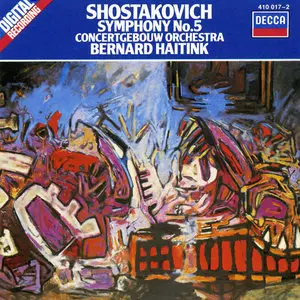Dmitri Shostakovich: Symphony Nr. 5 - Bernard Haitink, Royal Concertgebouw Orchestra
XLD | FLAC (tracks) | No Log/cue-sheet | Coverart Embedded & High-def JPEG | ~236 Mb
Classical | DDD | Decca 410 017-2 (1981)
The Symphony No. 5 in D minor, Op. 47, of Dmitri Shostakovich was composed between April and July 1937. Its premiere was on November 21, 1937 in Leningrad by the Leningrad Philharmonic Orchestra under Yevgeny Mravinsky. The work was a huge success, and is said to have received an ovation of at least 40 minutes, according to Mstislav Rostropovich. It is still one of his most popular works.
The finale of the Fifth Symphony, which has been called grandiose, has remained the topic of continual discussion revolving around the question, "Is it a Stalinist victory hymn or is it a parody of one?". If it were meant as a parody, the bombast of the coda would have to be deliberately pitched so it would sound ridiculous; this would underline the hypocrisy of the apparent tribute. However, this final movement, often being criticized for sounding shrill, is declared in Testimony to be a parody of shrillness, representing "forced rejoicing". In the words attributed to the composer:
“The rejoicing is forced, created under threat, as in Boris Godunov. It's as if someone were beating you with a stick and saying, "Your business is rejoicing, your business is rejoicing," and you rise, shaky, and go marching off, muttering, "Our business is rejoicing, our business is rejoicing."”
This is symbolized by the repeated "A"'s at the end of the final movement in the violin and upper woodwind sections. It includes a quotation from the composer's song "Rebirth", accompanying the words "A barbarian painter" who "blackens the genius's painting". In the song, the barbarian's paint falls away and the original painting is reborn. It has been suggested that the barbarian and the genius are Stalin and Shostakovich respectively[citation needed]. The work is largely sombre despite the composer's official claim that he wished to write a positive work. Though impossible to confirm, it seems evident in many passages that Shostakovich did not intend to compose a mindless triumphant symphony in an attempt to reenter the Russian music scene with the approval of the Stalinist regime. The march in the first movement is more of a parody of marching than one that draws the feet to tap the beat. The third movement is invariably sad, nostalgic and haunting rather than depicting the struggle of the working class or other progressive ideas. The fourth movement also introduces one of the only themes not based on the first two themes of the opening movement, drawn from a previous composition about an artist being criticised and the final moments of the symphony seem disguised.
This recording was made in the series which Haitink undertook between 1977 and 1984, with the London Philharmonic Orchestra and the Concertgebouw Orchestra Amsterdam. Although it was re-released later on, this is the original CD release from the 80's, with the original cover. A must hear recording!
Tracklist:
1. Moderato
2. Allegretto
3. Largo
4. Allegro non troppo
NOTE: new download links! Former Rapidshare links have been deleted by RS. Now available again at FileSonic!
RAR-Password: haitink
P.S. If you enjoy these posts, please feel free to leave a comment or look at my other posts.



